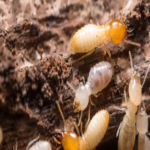I recently tried using beneficial nematodes to control ants on my land. Not that it was really necessary: I’m pretty open to ants as long as 1) they stay outdoors and don’t invade my house and 2) don’t attack humans. But I had recently taped a TV show about the use of nematodes with the result that I was able to take home a sample of a product called Ant Out Nematodes. Since I had the product in hand, I thought I might as well give it a try and write a blog post about the results.
(This is actually quite new; previous nematode treatments required the product to be refrigerated both in the store and at home.) It has a limited shelf life, however, having to be used within a year of its use. been bought.
background story
Nematodes are microscopic worms. There are thousands of species, some of which are harmful to plants, but many others are pests of insects. This is the case with Steinernema feltiae , the nematode species used in the Green Earth Ant Busters product. Besides ants, this species can treat other pests such as flea beetles, house flies, saw flies and sciarids (mould gnats). Other species and strains of nematodes are available to control grubs, chinch bugs, fleas and other pests.
A try
The little brown ants aren’t bothersome and I haven’t tried to control them. Photo: University of Nebraska Extension
I have dozens of colonies of brown field ants ( Lasius neoniger or other similar species), small ants that form small, crater-like mounds of spoil with an entrance hole in the center. I find them in my lawn, flower beds and through the paving stones. They are essentially beneficial: they aerate the soil, collect detritus and do not harm my plants. Sometimes they come into our homes looking for sweets, a behavior that I find unacceptable, but not in my house, at least this year. I never bothered to try and eliminate these little ants, and I have no intention of doing so: live and let live, I tell myself. I guess most other gardeners feel the same way about these common little ants.
Black field ant nests are larger and damage or kill nearby plants. Photo; uwm.edu
However, there were also two colonies of black field ants ( Formica spp.) on my land. They are larger ants, usually black (the color of mine), red or black and red, and they build larger anthills of spoil with multiple entrances. They are not carpenter ants (the latter only live in association with wood) and they almost never enter our homes, but their large nests often destroy plantings and sections of lawn, mainly by burying plants and undermining their tunnel root zone. These ants will bite if you attack their nests, but their bite is more startling than painful. Also, colonies of field ants have a good longevity: up to 10 years.
A colony was located in my lawn and besides had been there for probably 6 or 7 years already. Not being a fan of the perfect lawn, I had never bothered trying to remove it before. Besides, I had the impression that this colony was in decline, because the anthill was lower and less maintained than before and the ants seemed less vigorous to me. I will call this group the lawn colony .
The treatment
I first read the label on the product. He suggested preparing a solution and spraying it on the nests using the manufacturer’s sprayer, thus a more complicated and expensive effort. However, on the manufacturer’s website I found instructions for applying the nematodes using a simple watering can, a much more convenient solution for me.
The results
On the fourth day, no more ants came out of the colony of the lawn and the cuttings were completely leveled. Since then, just 10 days later, lawn plants (grasses and others) are already starting to regain their lost territory.










Leave a Reply